In a time of major crisis do not overlook the simple cord sling as a weapon or a hunting tool. It would fit nicely in your bug out bag because it is lightweight, easy to store and easy to use. Rocks or other projectiles to be used as ammo can also be easily picked up wherever you happen to be.
Even though the sling became less important as guns and other weapons became more available, slings are still used in Palestine and many other parts of the world for personal defense and hunting.
How Far Can a Sling Throw a Stone?
With a good arm and a good spin on the sling, the max range is about 100 yards.
Very few people can throw a rock that far and still have the energy to stun a man or an animal.
Types of Projectiles
Basically projectiles are stones, pieces of metal, or anything else you choose to launch. As long as the projectile fits into the pouch, and can be spun, it can be released. The heavier the object to be launched, the shorter is the range.
Making a Modern Sling

Materials:
- 2 pieces of paracord or braided rope. You can also use braids of leather cord, but make sure you braid together enough leather strips to make two pieces of cording.
- Small piece of leather or thick canvas for the pouch. A 4“ x 2“ piece should be more than enough for leather. Make the pouch 1/2“ bigger for canvas.
- Optional Materials: metal rings or grommets designed to protect holes in canvas (not needed if you use leather).
Tools:
- Leather punch or knife
- Scissors
- Small ruler
- Long stick matches or candle lighter
- Optional Tools: needle and thread if you are going to use canvas for the pouch.
Special Skills:
You must know how to tie taut line hitch knot and half knot.
Step 1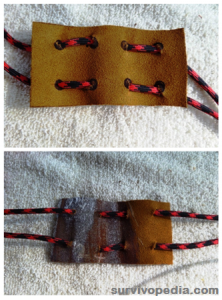
Measure leather with ruler and cut into 4“ x 2“ strip. If you are going to use canvas, make the square a little bit bigger so that you can sew off the borders.
Do this by folding a small bit of fabric under, iron it, and then fold again so that the raw fabric is not exposed. Sew through all the way around the square and through the layers.
Step 2
Punch or cut 4 holes along the top and bottom of the 4 inch sides.
There should be enough boundary around each hole to prevent the leather or canvas from fraying or tearing.
Step 3
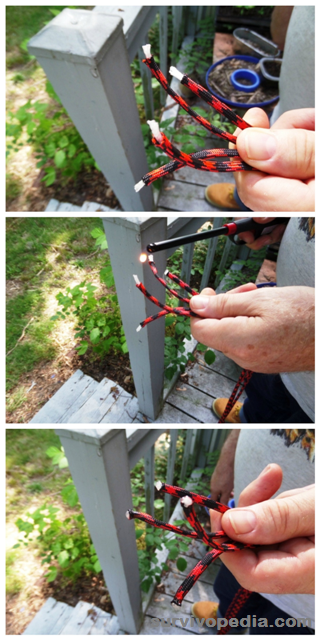 Cut 2 paracord, braided rope or leather braid lengths to about 7‘each.
Cut 2 paracord, braided rope or leather braid lengths to about 7‘each.
When testing and measuring the sling it must not hit the ground. If it does,you will have to shorten both cords.
Step 4
If you are using paracord, seal off the ends by burning with candle lighter, and then quickly dipping in cold water.
Do not touch the ends for some time, as they will retain heat for a bit and burn your fingers.
Note – paracord will stretch, so do not make these cords too long or you will have to shorten them later on.
Step 5
Thread one cord through each of the four holes in the bottom and top of the 4 inch edge of the leather or canvas.
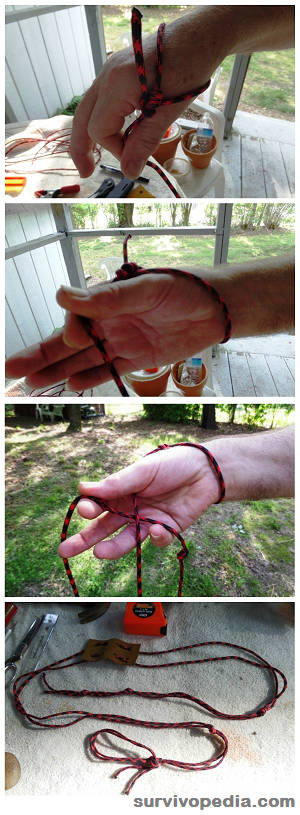
Starting by coming up threw the first hole, then down threw the second hole, up threw the third hole, and down threw the fourth hole.
Step 6
Pull each cord so the pouch is at the bottom of the loop and the paracord is equal at the top.
Step 7
Tie a half knot about a foot from the pouch to help stabilize the cords on each side of the sling.
Step 8
If you have too much paracord or leather left over on each side, cut away the excess, and then re-seal the paracord with candle lighter.
Step 9
Make a loop to fit your hand and wrist through one cord. Make a taut line hitch knot and adjust so that the cord is comfortable around your wrist.
Step 10
On the other cord, tie a half knot at the point where you will grab that cord when spinning. When holding the sling, there should not be any slack in either cord. The knot is there to help you feel which cord needs to be released while operating the sling.
How to Load, Spin, and Release a Projectile From the Sling
Here is my favorite way to hold and use this type sling:
- Put your hand through the loop cord with the cord falling between the thumb and the first finger on the palm side of your hand.
- With thumb and the first finger, grasp the knot on the release cord. At this point the loop cord should be enclosed in the circle formed by the thumb and first finger.
- Hold the sling with the pouch hanging freely, load and center the rock in the pouch.
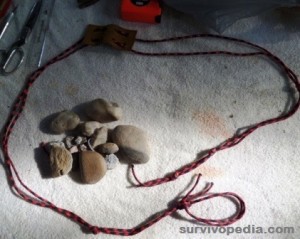 There are two ways to spin the sling:
There are two ways to spin the sling:
- Underhand spin: After loading the sling, swing the sling forward as if you are pitching a softball. Swing from the shoulder not the wrist. Think of the sling as an extension of your arm. Release the knot cord so that the rock will the leave the pouch at about a 45 degree angle from the ground. When using the underhand spin it is possible to get a running start. This spin is good for power and distance, but lacks accuracy. Practice to get the release point.
- Over the head spin: Start with an underhand and forward spin. As the sling is swirling on your power side bring it over your head by bending your elbow. The sling will be spinning parallel to the ground. Remember that the cords are an extension of your arm. As the sling spins forward release the knot cord as if you were throwing a hard baseball. Practice to get the release point.
Before using a sling or practicing with it, make sure that:
- There aren’t any buildings in the impact area that might be damaged if hit by projectiles.
- There aren’t any people or animals in the the impact area (other than those you are intending to hit).
- Remember slings are deadly weapons. As simple as they look, slings can kill or inflict great bodily harm if misused.
The double cord sling is a good addition to your bug out equipment because it is small and easy to carry, ammo is easy to get, and they are effective for hunting and self defense.
Like any other weapon, practice is mandatory to keep up your skill. When all of the modern weapons are broken or discarded the simple two cord sling will still be here to defend your family or to use in hunting, just as it has for other people for many thousands of years.
This article has been written by Fred Tyrell for Survivopedia.




























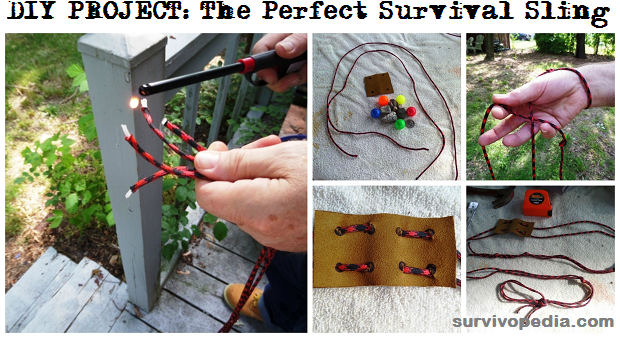








































Hey, I’m a naturalist\survival student, I have been my entire life (although it wasn’t til I was older that I realized it for myself), all my life I tried being other people, to better myself, and be a more socially recognized and admired person… I tried hard and it worked, some what! But others and myself noticed something just wasn’t right.
These days, I’m everyday practicing to be a better person still, the difference is I don’t care of other peoples opinions\judgments of my lifestyle, I am an extraordinarily talented man when it comes the cosmos, world geology, a common sense of our environment and everything around me, my body is the perfection of nature. The meticulousness in every movement when I create or build with my patient hands and wisdom!… Whatever my body attends, gets attended that every small molecular movement I make, has a procedure to be followed and nurtured to become a little closer to perfect with each repeated performance of that task.
If a person followed a procedure and continued trying to make everything he\she does a little better with each execution of whatever their doing, there is nothing any one of us human beings can’t do!
Yeah,,, it was supposed to say;” gets attended KNOWING that every small…..”
Hahaha… Mistakes are ok, as long as we realize them and keep trying to better ourselves always…
Peace ✌
Whoa there. That was a little E D G Y